Ing's SST Rules of Go
S tones and
S paces are T erritory
Janice Kim, Michael Simon, and Phil Straus
- * New ko rule avoids annulled games without allowing false-eyed
groups to kill real-eyed groups
* Simple, at-a-glance counting system
reduces possibility of error
* Disputed positions may be played out,
without eliminating the question of skill
* New provisions aspire to
maximum freedom in how the game is played
* Free placement of
handicap stones
1 Introduction
We are going to examine some revisions to the rules
of Go which were proposed by Mr. Ing Chang-ki. To understand their
significance, we should first review some of the background.
China, Japan, and Korea all have different rules. The nature of the
game is essentially the same in each system, but a number of incidents and
the growth of international tournaments has underscored the need for
protocol. Although the basic rules are simple, written rules that govern
every possible situation fairly are as difficult as understanding those
situations. Our intention here is to illuminate the major issues and
discuss the ramifications of the Ing rules as guidelines for tournament
directors and players. It is beyond the scope of this article to explore
fully the principles or motivations of a system of rules, or to prove the
superiority of one system over another. Each system has some merit, and
some difficulty.
Recently, a number of systems were proposed. The AGA rules compromise
between territory and area counting in a way which tries to yield the same
result regardless of which counting system is used. An elegant
mathematical proof by Robert High detailed how in an even game, if pass
stones were used to allow playing out all situations, the result would be
the same in both systems. Unfortunately, handicap conventions differ in
area and territory counting.
AGA rules use Superko , which deals with the problem of complex
or multiple kos. Under Superko, no full board position may be repeated.
Superko handles triple kos without too much difficulty. A question arises
in "multiple unbalanced double kos," detailed in Part 6B. In this case,
stones without eyes may rise up from the grave to kill under Superko.
Until now, Superko advocates claim that since the difficult situations are
so rare, the benefit of having a simple rule outweighs the disadvantages
of having a questionable rule. Unfortunately, the rule that the full board
position may not be repeated is simply stated, but in implementation the
players must remember the game perfectly to ascertain when the rule is
broken. This is not simple even for professionals when faced with these
situations.
The problem of complex or multiple ko is similar to basic ko: the
potential for endless repetition. Were this situation allowed, the
progress of the game would be stopped and no result possible. The Korean
Go Association, loath to take away the right to play, annuls all games
with complex or multiple kos unless one side concedes local defeat. Mr.
Ing points out that annulling games can be an unsatisfactory solution. The
Ing rules outlaw endless repetition by converting many complex kos to
basic kos. This allows the players to continue their contest and determine
a result. The Ing rules also put the burden on the instigator of a cyclic
sequence, allowing full board repetition while not impeding progress. This
may be an improvement over the Japanese rules in that it seems more
natural that the person with a logically superior position is permitted to
play.
By using area counting, the Ing rules eliminate the necessity of
authority and precedent to solve the problem of capturing dead stones
without a loss of territory, while leaving the question of skill. Whether
or not one needs to "play an extra stone" still involves a question of one
point, as playing inside one's own territory instead of a neutral point
entails a one point loss. Since one does not rearrange territory during
Ing counting, or need to keep track of prisoners, mistakes are minimized,
and dishonesty nearly impossible.
The Ing rules contain provisions which aspire to a maximum freedom in
how the game is played. For example, Ing rules allow a group to "suicide"
by taking their own last liberty and forcing their own removal. See
"Suicide" in Part 4.
The free placement of handicap stones is an interesting addition,
particularly for those who play many handicap games with the same
opponents. Freeing the placement of handicap stones may add spice to these
repeated encounters.
The Ing rules are essentially area counting with a modified ko rule.
They may be suited to the needs of American Go players, since they are
often simpler in practice than other rules, do not rely on authority or
precedent, and make many disputes moot issues. We are now in a position
where we can and must choose a protocol without bias.
2 Playing the Game
Start of the game
1. Verify that both players have exactly 180
stones.
2. The older player takes a handful of white stones, and the younger
player selects one or two black stones, signifying odd or even. A correct
guess enables the younger player to choose a color; otherwise the older
player chooses. In Japanese and Korean rules, the correct guesser
takes Black.
3. At the beginning of a handicap game, Black may place the handicap
stones anywhere on the board. Technically, Black always moves first.
In a game of handicap N, White's first N-1 moves are pass plays.
4. White receives 8 points of compensation in even games, given
during counting. 8 points of komi seems like a lot, but we are assured
that this is reasonable. Nevertheless professional players prefer
White.
During the game
1. Take turns playing a stone or passing.
Simply indicating a pass is all that is necessary.
2. Captured stones are returned to the opponent 's bowl. All the
stones are eventually placed in their color's territory, so you don't need
to keep prisoners in any special place.
3. Self-capture of single stones is equivalent to a pass play.
Suicide of groups larger than one stone is legal in Ing rules. This
may be useful as a ko threat or in changing liberty counts: keep in mind
by the suicide move one takes off one's own stones rather than putting a
stone on the board, so one cannot place any stones in atari or kill by
suicide. Also, there is no advantage other than the ones described in Part
4 and no point gain by suicide.
4. Immediately capturing a stone that has captured in ko is
illegal. This is basic to every rule system.
5. Complex kos convert to basic kos. A cyclic sequence may be
initiated by a player once and only once during the game. Explanations
of the rules for complex and multiple kos are in Part 6, "The Ing Ko
Rules."
6. Unintentional illegal moves are retracted without penalty.
The spirit of this rule is that no one will forfeit because of a
technicality, as when Go Sei Gen was forced to forfeit because he answered
a move on a neutral point with a move on another neutral point, when the
Japanese rules at the time prohibited playing a neutral point while the
game was not yet over. Note that an unintentional and illegal move is
extremely rare, and players should be advised that it implies
unfamiliarity with the situation. The move must be illegal, not simply
unintended or unfavorable, to be considered a candidate for retraction,
and the player of an illegal move must present some compelling evidence
that the move was unintended, for example, the move in the Honinbo game
which resulted in forfeiture because the monitor implied that it was the
wrong person's turn to take a ko.
Ending the Game
1. Continue alternating plays until all neutral
points have been filled.
2. Two consecutive passes signal an adjournment of the game to
discuss the status of groups. If the players agree about the status of
groups, the game is over. Otherwise, play resumes until disputes are
resolved. When agreement has been reached, two more passes signal the end
of the game.
3. Since you can play in your own territory without territorial loss,
play out any situation in which there is a dispute after the game is
over. Keep in mind that playing inside your own territory is not a
loss but it is not a gain, while playing a neutral point is worth one
point. Also, note that when we assign point values to endgame, this is a
relative, not an absolute term: we say "half-point ko" in order to
indicate that it should be played after one point moves, not because it is
actually worth half a point. In Ing counting, technically every move is
"worth" an extra point, so neutral points are the smallest on the board,
but should be played before putting stones in your own territory. Be aware
that Ing counting does not change how you should play, except that you
should take care to fill in the neutral points at the end of the game.
This kind of counting is useful only in that it eliminates certain very
rare problematic situations; only the method of counting, not the play or
the result, is different.
Note that if a point is overlooked, the person whose turn it is (a pass
is a turn) should play it, but after the final pass or counting has begun,
an overlooked point should be left empty, and play may not resume. Also
note in area counting it doesn't matter whose turn it is in a dispute
about the status of groups. In the past a disputed position was disputed
only because one side did not want to spend extra stones taking out a dead
group, thus losing points in territory counting. This is not a question
about life and death, but about territory counting itself. Players should
be advised that in Ing counting this question is moot, and giving pass
stones is unnecessary and has no effect. After filling in neutral points,
in practice both players may simply agree the game is over and begin
counting, without the formal process. For example, if there is a bent four
in the corner surrounded by a live group and no seki on the board, the Ing
rules allow but do not require insisting that the group be taken off.
Playing out this situation is only to avoid the argument already made moot
by area counting, and has no potential to change the result.
Counting
1. Dead stones are returned to your opponent.
2. Fill in all your own territory with your remaining stones. Do not
disturb the borders of your territory. Unlike territory counting, one
counts one's own area.
3. In sekis, there will be shared points which neither player can
play, and are not territory. Fill such shared points alternately with an
equal number of black and white stones, leaving one shared point empty if
there is an odd number. If there is more than one seki, each side fills in
an equal number of shared points, leaving only one if necessary.
4. In even games, place four White stones in Black 's territory for
compensation. This is equivalent to Black giving White 7.5 points of
compensation in territory counting. If you have empty points left in your
territory, you have won. If you have stones left over and no territory in
which to put them, you have lost. You can see who won at a
glance.
To determine the margin of victory, place the "losing" stones, if
any, in the winner 's territory. At this point, there should be only one
empty point left on the board, the "winning" point. The margin of victory
is the winning point plus twice the number of losing stones. See Part
3. If there is an odd number of shared points in a seki, the empty
point will be in the seki. Then the margin of victory is just twice the
number of losing stones. Only in this case can there be a tie. Black wins
ties.
5. In handicap games of N-stone handicap, White must receive N-point
compensation to make the result equivalent to territory counting. If N
is even, White places N/2 stones in Black 's territory. If N is odd, White
places (N-1)/2 stones in Black's territory, and one point of Black
territory is left open. In this case the margin of victory is just twice
the number of losing stones. In handicap games, White wins ties.
Note that Black giving compensation in handicap games is not found in
any official documentation of the Ing rules. AGA President Phil Straus has
requested this convention so that territory and area counting can give the
same result in handicap games. If there is an odd number of shared points
in a seki in an odd-numbered handicap game, there will be two empty points
at the end of the game, and an extra stone. This is a losing stone and is
added to twice the number of losing stones on the board to find the margin
of victory. This may eliminate some of the visual simplicity of Ing
counting. It is not clear that area counting should be changed to coincide
with territory counting and not the other way around; the other way is
simply to give Black "the N Advantage" in N-stone handicap games.
Special note: What to do if stones are lost.
It is obvious when
either side does not have the required 180 stones at the end of the game,
because there should be one and only one empty point left on the board
after counting. However, all is not lost if stones are missing, because
they can be counted at this point and those missing simply replaced. A
problem of this sort can be rectified in less than two minutes, as was
demonstrated at the World Youth held in Palo Alto. Although it is true
that having exactly 180 stones each is helpful, anyone with a little
practice can get around the problem of not having the exact number of
stones, so this in itself should not be the cause of rejecting area
counting. In fact, territory counting does not circumvent the problem of
missing stones, it merely assumes that stones are not misplaced during
counting.
3 Demonstrations of Ing Counting
- Here are three 9 x 9 games. Each player started with 40 stones.
Remove the dead stones and return them to your opponent. Fill Black's
area with black stones and White's area with white stones.
Even Game Counting
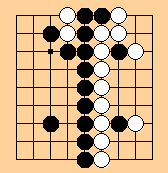
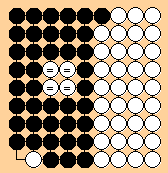
Put four white stones in Black territory (equivalent to White receiving
8 points of compensation.) These are marked with an "=" in the
diagrams.
White then has one stone left over and Black has two empty points, so
Black has won. White puts the stone in Black's territory. Black wins by 1
(winning point) + 2x1 (losing stone) = 3 points.
The winner can be determined visually.
Handicap game counting
Even-numbered handicap

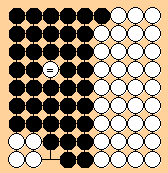
Two Stone Handicap White adds one stone (handicap/2) to Black's
area for compensation. (This makes the result equivalent to territory
counting.) After filling the territories, White has four stones left over,
and Black has five empty points, so Black has won. White puts the four
stones in the winner's territory. Black wins by 1 (winning point) + 2x4
(losing stones) = 9 points.
Odd-numbered handicap

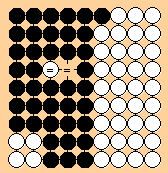
Three Stone Handicap White adds one stone (handicap-1)/2 and an
additional point is left in Black's territory for compensation. After
filling the territories, White has four stones left over and Black has
four empty points, so Black has won. White puts the four stones in the
winner's territory. Black wins by 2x4 (losing stones) = 8 points.
4 Suicide
Two ways self-capture can change a game.
1. Suicide can create a ko threat.
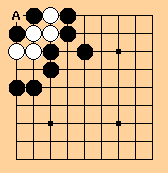
Black can play at A as a ko threat. This threatens another play at A,
which would kill White. Note a Black play at A is equivalent to taking the
two Black stones off the board, and is a complete turn.
2. Suicide can change liberty counts.
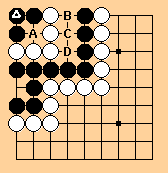
If Black were not allowed to play at A, White would win the capturing
race. White can capture at any time, for example, by White B, Black C,
White A, Black  , White D.
, White D.
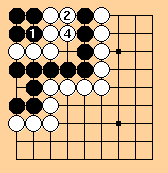
Black 3 at 1.
With suicide legal, Black can reduce White's liberties by playing at 1.
(The black stones are immediately removed.) White tries to capture with 2
and 4 -
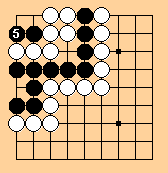
White cannot fill the last shared liberty. Both groups live in
seki.
5 Bent four in the corner
In Ing rules only, life or death of bent
four in the corner is related to the whole board. In the absence of a seki
or involvement in a capturing race, bent four in the corner can be
captured at the end of the game without any loss. In the presence of a ko
threat that cannot be removed (i.e., a seki) bent four in the corner may
live or be exchanged. In a capturing race, bent four in the corner may
kill or be killed depending on the number of liberties.

No ko threat, no capturing race. White is dead. Black may
start the ko to capture at any time with A, White B, Black  , White
, White  , Black A.
, Black A.
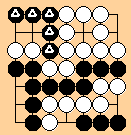
Ko threat
smaller than the corner. Black should give up the marked stones to capture
the corner.

Ko threat larger than the corner. Black loses the marked
stones (more than Black gains) by killing the corner, so Black should let
White live.

Capturing race. The first player to play wins.
6 The Ing Ko Rules
A. Fighting Kos
In Ing rules, complex kos are converted to basic
kos. A stone that has captured in a basic ko cannot be captured without an
intervening move or pass play. Stones that may not be captured immediately
are called HOT STONES. Stones that have captured in a basic ko are one
type of hot stones. Immediate capture of hot stones is prohibited because
allowing it would stop the game's progress.
Hot stones may be captured only after an intervening move. Hot stones
may be multiple stones, not just single stones.
Double hot stones
This is a classic situation called sei-cho in Japanese, or "long
life." White can kill Black by playing at A, so Black plays at A. White
captures two stones. Next Black can capture two stones. White must throw
in at  to
continue the attack, and Black plays at A again.
to
continue the attack, and Black plays at A again.
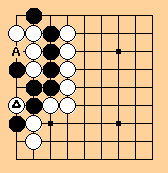
Long life.
Under Korean rules, this game is annulled unless one side gives up the
right to continue in this repetitive position. Under Superko, White may
not immediately throw in at  because that would repeat the
initial position. Black can live by playing at
because that would repeat the
initial position. Black can live by playing at  .
.
In Ing rules, this complex ko is treated as a basic ko. The two
connected stones become double hot stones and can't be captured after
capturing without an intervening move or pass. (See the following three
diagrams.) Note that White may capture immediately at 2 because you may
capture stones before they become hot. (At 1, Black has not captured
anything yet.) Since they have captured, now the White stones are hot so
Black may not capture them immediately.

Black 3 ko threat
elsewhere. Assume 4 responds elsewhere.
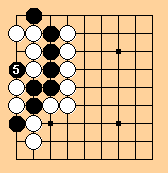

8 and 9 elsewhere. 11
elsewhere, etc.
Note every rule system distinguishes hot stones in basic ko. For
example, in this position, if White has played at 1 without capturing,
Black may capture it without making a ko threat. Ing rules extrapolate the
concept of hot stones to complex kos.

Twin Hot Stones
Triple ko - Single hot stones
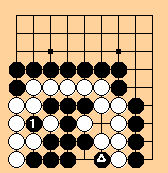
In Ing rules, this triple ko converts to a basic ko - if Black takes at
1, White may not capture 1 or  immediately. These become twin
hot stones. White must play elsewhere before capturing; once one twin
captures and becomes hot, so does the other.
immediately. These become twin
hot stones. White must play elsewhere before capturing; once one twin
captures and becomes hot, so does the other.
Triple ko - Single hot and double hot stones
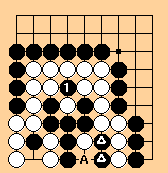
This situation also converts to a basic ko. When Black captures at 1,
White must play elsewhere before capturing Black 1. White cannot capture
at A either because the marked black stones and Black 1 are twin hot
stones. You may think of these as fraternal, not identical twins.
B. Balanced Kos
In a balanced ko, after a player initiates a
cyclic sequence, called DISTURBING, the same player may not disturb the
situation again for the duration of the game. Balanced kos are
distinguished in that each side must have the same number (at least two
each) of separate internal liberties.
Balanced double ko - Seki, no ko threats

The two groups on the right side are both alive in a double ko. Notice
that both sides have two separate internal liberties. It is a seki in all
rule systems. Notice the local situation can never become cyclic under the
rules of basic ko.

The problem comes with the situation in the upper left corner. White is
not alive, but insists that Black prove it. When Black captures at 1,
White uses the double ko as a ko threat at 2. Black must respond, so then
White can capture Black 1. It seems that Black cannot take these stones
off. In Ing rules, since the lower right is a balanced ko, White may
disturb once and only once (and Black may disturb once as well so as a ko
threat it cancels out), so White cannot keep the upper left in suspended
animation. In this way, a balanced ko cannot be used as a ko threat, and
false-eyed groups will die. Although the Ing rules offer that stones are
not dead unless they can be captured, the result is comforting: at the end
of the game, the result is as one would expect.
Balanced quadruple ko - Seki, no ko threats
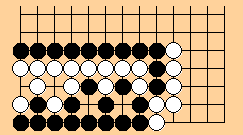
Since each side has two separate internal liberties, it is a balanced
ko. A player may disturb the situation once and only once in the game, so
under Ing rules this is a seki, since neither side can capture the other.
Note that both sides may disturb or start the cycle once, so it cancels
out as a ko threat, and the whole board position may repeat. As in the
previous example it cannot be used to fight a ko.
Unbalanced double ko -
Dead but a fount of ko threats
This situation arises in a variation of the Large Avalanche joseki,
here reproduced in miniature.
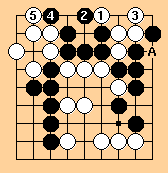
Since Black can always connect at A, push into the corner, and capture
White, this situation is not a seki. It is not a balanced ko because White
has only one internal liberty. A double ko cannot become cyclic by the
rule of basic ko. Therefore, White may freely play in this area. White
wants Black to spend moves taking off the dead stones, but Black doesn't
want to take time out to do this in the middle of the game. So as it
stands, if another ko starts elsewhere on the board, White will have
seemingly endless ko threats. But at the end of the game the White stones
can be taken off easily, so they pose no technical problem.
It's perfectly legal in any system.
What kind of ko am I?
The most common mistake is in confusing external with internal kos.
Look at the following example. Can you tell what's going on here?

In every rule system White is dead. In Ing rules, if White claims to be
alive in ko, those kos must be balanced, but in that case, a player cannot
disturb more than once. If White claims to be alive, White can play at A
in response to Black 1 only once, after which White may not take here
again and is helpless to avoid eventual capture. It may be simpler to
observe the ko on the left is external so this is actually just an
unbalanced double ko. White is being unreasonable even to think of this as
a potential balanced ko, because White has only one internal liberty.
White may of course use A and B as nearly endless ko threats during the
game, because it is an unbalanced double ko.
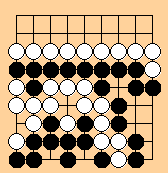
This situation is different. In this case all three kos are internal.
Each side has two internal liberties, so the position is balanced. Each
side may disturb only once (so this is a bankrupt position as far as ko
threats are concerned) and both live in seki. Notice that even though
prohibited from disturbing more than once, neither side can then be
captured. That is why this is seki and in the previous example White is
dead.
The questionable case in Superko
Here are two unbalanced double kos. If looked at in isolation, Black
has dead groups in both the upper left and the lower right corners, and
each local position cannot become cyclic by the rule of basic ko. However,
because there are two unbalanced double kos, the whole board position may
become cyclic. We would expect that any ko rule would not force White to
die because Black has two dead groups.
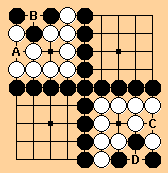
Black captures at A. White can take at B, Black takes at C, White takes
at D, then Black takes B, White takes A, and Black takes D. Now White
wants to capture C. Under Superko, White would not be allowed to make the
capture. Black could then kill the lower right White group.
Under the Ing ko rule, each side is allowed to initiate a cyclic
sequence, even one that involves the whole board, once but only once.
Since the whole board position may repeat, White is allowed to capture at
C but Black will then be prohibited from capturing at A, starting a second
cycle.
To avoid capture, the false-eyed player will need to begin the ko
cycle, but will then be prohibited from initiating the cycle a second
time, and so will die.
7 The Clock
When playing with the clock, one may use the system of
"second counting," or the Ing Time Purchasing System, depending on the
instructions of the tournament director (TD). Since it is impossible to
legislate sportsmanship in the rules of play, there are problems with
malfunctioning clocks and language barriers, and TDs are not able to watch
every game, players should be aware that this is fertile ground for
unfortunate situations. Although if one's clock indicates that one has
lost, one has lost, there are a number of situations which should be
clarified. A non-exhaustive list includes:
At the beginning of a game, players should not start the clock of an
absent opponent unless specifically instructed by the TD to do so. The TD
may impose a time penalty for not being present at the announced starting
time, usually twice the elapsed time.
During the game, if one's opponent is absent, one may play and press
the clock, but it is polite to indicate the move played when the opponent
returns. It is not rude to leave the board. It is not necessary to remind
your opponent to press the clock, but it is polite if you notice that the
clock is malfunctioning to your advantage to tell your opponent.
If a player observes that the clock is malfunctioning so that the game
cannot fairly continue, that player should announce the intention to pause
the clock, and after pressing the SET button on an Ing clock (do not turn
off an electronic clock), call the TD. Make sure you know how to pause the
clock, as turning it off unfortunately must result in forfeiture unless
both players and the TD agree on the time left for both sides. Watch your
clock carefully, as the TD can only replace a broken clock, not
arbitrarily reimburse you for lost time if your clock malfunctions, and
must assume that the time indicated is correct unless both players and the
TD agree to an alteration.
In case of significant disruption, the players or the TD may pause the
clock. Players should inform each other of their intention to pause the
clock and summon the TD without looking at the board. The TD will resume
timekeeping.
During overtime, If one player MUST leave for a short time (i.e. a call
of nature), it is acceptable behavior to ask permission of one's opponent
to pause the clock. The opponent must openly refuse in this case in order
to declare a victory on time if one's time elapses.
In the following cases, the TD may call on the highest ranked
player present to adjudicate or declare a victory based on the frozen
position on the board:
- During the game, if the clock indicates that you have lost on time
due to a malfunction, and your opponent agrees that the clock has
malfunctioned and the players and the TD do not agree to an amount of
time left; or
If the clock ceases operation altogether or indicates that both
players have lost on time, and the players and TD cannot agree on an
amount of time left.
During the game, if the clock indicates that you have lost on time and
you believe that it has malfunctioned, but your opponent does not, you
must forfeit unless you can demonstrate to the TD that it is not possible
that you have lost on time. If the players and the TD then do not agree to
an amount of time left, the TD may call on the highest ranked player
present to adjudicate. Notice that sticky buttons or failure to push your
clock do not indicate that a loss on time is impossible.
These cases only refer to games with no official monitor; if there is
an official monitor, that person is responsible for maintaining a
functioning clock, resetting the clock if he or she deems it necessary,
and declaring any victory on time. If you have no official monitor, by
agreeing to play you are agreeing to cooperate with the TD, even if he or
she is absent during the incident or you do not agree with any of the
steps taken, unless they directly contradict the written rules for that
tournament.
To avoid any argument, one should specifically and immediately (before
playing the next move) announce a win on time if the opponent's clock runs
out. Once a game is resigned, or there is cause to believe that the last
significant move has been played, or a result reported by the players to
the TD, a victory on time may not then be called. After both players
verify the score and the game has been cleared, the result may not be
changed.
If one player indicates that he or she believes with cause that the
last significant point has been taken (the abstract definition of the end
of a game of Go), a victory on time may not be called against that person.
The official monitor, if there is one, stops keeping time for that person
at that point. In a game with no monitor, if a person believing with cause
the game to be over then "runs out of time," that player cedes any
unclaimed points and the chance to make needed protective moves, but does
not lose on time or lose the right to demonstrate a group's status by
defense or removal, although an immediate response is required.
The spirit of this rule is that it is impossible to fairly involve
the use of a clock after the game is over in a game that ends by mutual
agreement. Otherwise, in a sudden death or time-purchasing situation,
one player may legally force the other to go over the time limit by
pointlessly continuing or spuriously challenging the status of groups. The
purpose of the clock is thwarted by rewarding rather than penalizing
playing indefinitely, and its use after the last point has been taken
serves only to invite gamesmanship. In a game of second counting this rule
may seem overly flexible, but since it only protects and does not penalize
(one player is not receiving more time to potentially change the outcome
on the board) it is recognized as advantageous to both players to
eliminate the injurious effects of potential gamesmanship. On the other
hand, players should be aware when an opponent is trying to win on time,
and be especially careful to avoid ambiguity.
This lengthy discussion of the uses of the clock is made necessary by a
possible misunderstanding by Western players of Asian rules concerning the
clock. The rules of Go on this issue have not been widely established in
the American Go community. This is perhaps because of an impression that
they are understood, much in the way that the general rules of Go are
believed to be understood. Unfortunately opinions vary on exactly what the
rules are.
These guidelines are not required by Ing rules, but they are suggested
to TDs unless they specifically set forth another set of guidelines, and
submitted to players as an overview of the unwritten rules governing
professional play.
8 Summary
We have now examined some of the major issues together.
Our hope is that readers will be able to make informed decisions keeping
some facts well in mind:
1. Every rule system is extraordinarily difficult. Dismissing these or
any rules as overly complex is to make the erroneous assumption that there
are simpler rules.
2. The nature of the game is that it may be required to decide without
being able to prove that one rule is more desirable than another. For
example, who should be prohibited to play in a cyclic position? It only
matters that the rule should be consistent; there are legitimate arguments
for both sides.
3. Since the fundamental nature of the game is the same in all rule
systems, and problem cases are rare enough to not affect the enjoyment of
the game, deciding on a rule system or allowing the sponsors of a
tournament to decide on a rule system is not a moral issue.
4. Studying the rules is not that much fun, but Go should be.
Credits Michael Simon had the idea of writing this document, which Phil
Straus approved. Michael and Phil created outlines. Janice Kim wrote the
text. Layout and graphics by Michael with help from Phil. Thanks to the
many reviewers for their suggestions. Many of the examples are from
Ing's SST Laws of Wei-Ch'i 1991 by Ing Chang-ki. Some are from
Simplified Ing's Goe Rules by Sidney Yuan.





























